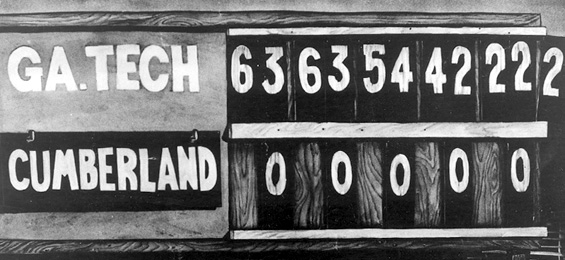Day 1:
Went shopping with the other zombies.
Saturday, December 22, 2012
Wednesday, December 19, 2012
Saturday, November 3, 2012
The 5760 Point Football Game
How many points can theoretically be scored in a NFL or NCAA football game?
First lets look at actual history and records:
The highest scoring game in National Football League history was on November 27, 1966. The Washington Redskins defeated the New York Giants by a score of 72-41 (combined 113 points).
Infamously, Georgia Tech defeated Cumberland 222-0 in 1916. The play-by-play account is a bit like watching a Road Runner cartoon.
Just for reference let's also examine a 1927 high school game , Haven (Kansas) High School scored 256 points in a regulation 48 minutes game (38 touchdowns). Haven High scored a touchdown on average every 76 seconds. If that touchdown pace was maintained in a 60 minute game, and followed with a successful 2-point conversion after each touchdown, a team could score 47 touchdowns for 376 points.
-------------------------------------------------
Doomsday Game from Hell Scenario: What if each team scored on every kickoff?
On the opening play of a 2003 NFL game between Philadelphia and Dallas, the Eagles tried an onside kick. Randal Williams caught the ball and raced into the end zone untouched for the fastest touchdown in NFL history - only 3 seconds ran off the clock! In reality, replays show that the clock started about 2 seconds late, so the actual time should be at least 5 seconds.
What if this happened on EVERY kickoff for an entire game? The two teams would score 720 touchdowns by the end of regulation time. There would never be a play from scrimmage. With successful 2-point conversions after each touchdown the teams would end up with 5760 combined points. We are ignoring that this requires each team to pile up over 8 miles of return yardage at track meet sprint speeds. Maybe a ten-seconds per touchdown pace would be more "Realistic" - bringing the combined point total down to 2880.
But is it possible to score more than one touchdown every 5 seconds?
Zero-Time Touchdowns
In college football, the clock does not begin on a kickoff until the ball is touched by the receiving team. In the NFL, that is the rule during the last two minutes of each half, the rest of the game the clock starts at the kick. This creates a peculiar scenario for college football. What if the receiving team NEVER touches the ball and every kickoff is recovered in the end zone by the kicking team? No time ever runs off the clock as touchdown, after touchdown is scored by the kicking team. At least in the NFL, some time runs off while the team runs down to recover the ball. That is - until two minutes are left in the half, and the timeless touchdowns begin. This is how football is played in Hell.
OVERTIME!
Until 2010, the NFL overtime rule was "Sudden Death" - the first team to score, would win the game. That limited additional scoring after regulation to 6 points. The NFL now has a modified overtime rule:
Each team must possess or have the opportunity to possess the ball unless the team that has the ball first scores a touchdown on its initial possession. Play continues in sudden death until a winner is determined, and the game automatically ends upon any score (by safety, field goal, or touchdown) Under these rules, it is possible to have up to 12 points scored in overtime (team A scores field goal, team B score field goal, either team scores a touchdown)
For NCAA Division I, when a game goes to overtime, each team is given one possession from its opponent's twenty-five yard line with no game clock, despite the one timeout per period and use of play clock. The team leading after both possessions is declared the winner. If the teams remain tied, overtime periods continue, with a coin flip determining the first possession. Possessions alternate with each overtime, until one team leads the other at the end of the overtime.
There is no limit on the number of overtimes, so both teams can add a combined 16 points per overtime - for eternity...
Back to the real world.
One sided routs were apparently more common in the 1920's. College football has not seen a 100+ loss since Portland State defeated Delaware State 105–0 in 1980.
But in recent years we have witnessed some high scoring shootouts like the 2007 Navy vs. North Texas football game (136 points - without overtime). Add multiple overtimes like the 7-OT 2003 Arkansas-Kentucky game (134 points), and I think it is likely that we may see a 160+ point game in the next few years. Even a 200+ point game is not beyond reason. I would put the upper limit at around 270 points (144 regulation + 126 in overtime).
Thursday, August 9, 2012
Subscribe to:
Comments (Atom)




